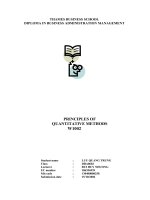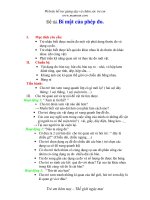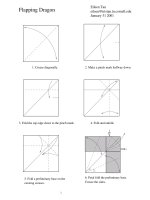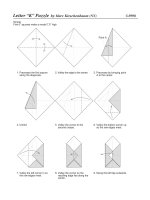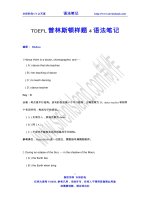Tài liệu Multimedia_Data_Mining_05 docx
Bạn đang xem bản rút gọn của tài liệu. Xem và tải ngay bản đầy đủ của tài liệu tại đây (734.11 KB, 35 trang )
Chapter 4
Soft Computing Based Theory and
Techniques
4.1 Introduction
In many multimedia data mining applications, it is often required to make
a decision in an imprecise and uncertain environment. For example, in the
application of mining an image database with a query image of green trees,
given an image in the database that is about a pond with a bank of earth and a
few green bushes, is this image considered as a match to the query? Certainly
this image is not a perfect match to the query, but, on the other hand, it is
also not an absolute mismatch to the query. Problems like this example, as
well as many others, have intrinsic imprecision and uncertainty that cannot be
neglected in decision making. Traditional intelligent systems fail to solve such
problems, as they attempt to use Hard Computing techniques. In contrast,
a Soft Computing methodology implies cooperative activities rather than au-
tonomous ones, resulting in new computing paradigms such as fuzzy logic,
neural networks, and evolutionary computation. Consequently, soft comput-
ing opens up a new research direction for problem solving that is difficult to
achieve using traditional hard computing approaches.
Technically, soft computing includes specific research areas such as fuzzy
logic, neural networks, genetic algorithms, and chaos theory. Intrinsically, soft
computing is developed to deal with pervasive imprecision and uncertainty of
real-world problems. Unlike traditional hard computing, soft computing is
capable of tolerating imprecision, uncertainty, and partial truth without loss
of performance and effectiveness for the end user. The guiding principle of soft
computing is to exploit the tolerance for imprecision, uncertainty, and partial
truth to achieve a required tractability, robustness, and low solution cost. We
can easily come to the conclusion that precision has a cost. Therefore, in
order to solve a problem with an acceptable cost, we need to aim at a decision
with only the necessary degree of precision, not exceeding the requirements.
In soft computing, fuzzy logic is the kernel. The principal advantage of
fuzzy logic is the robustness to its interpolative reasoning mechanism. Within
soft computing, fuzzy logic is mainly concerned with imprecision and ap-
proximate reasoning, neural networks with learning, genetic algorithms with
143
© 2009 by Taylor & Francis Group, LLC
144 Multimedia Data Mining
global optimization and search, and chaos theory with nonlinear dynamics.
Each of these computational paradigms provides us with complementary rea-
soning and searching methods to solve complex, real-world problems. The
interrelations between these paradigms of soft computing contribute to the
theoretical foundation of Hybrid Intelligent Systems. The use of hybrid intel-
ligent systems leads to the development of numerous manufacturing systems,
multimedia systems, intelligent robots, and trading systems, well beyond the
scope of multimedia data mining.
4.2 Characteristics of the Paradigms of Soft Computing
Different paradigms of soft computing can be used independently and more
often in combination. In soft computing, fuzzy logic plays a unique role.
Fuzzy sets are used as a universal approximator, which is often paramount
for modeling unknown objects. However, fuzzy logic in its pure form may not
necessarily always be useful for easily constructing an intelligent system. For
example, when a designer does not have sufficient prior information (knowl-
edge) about the system, the development of acceptable fuzzy rules becomes
impossible; further, as the complexity of the system increases, it becomes dif-
ficult to specify a correct set of rules and membership functions for adequately
and correctly describing the behavior of the system. Fuzzy systems also have
the disadvantage of the inability to automatically extract additional knowl-
edge from the experience and to automatically correct and improve the fuzzy
rules of the system.
Another important paradigm of soft computing is neural networks. Artifi-
cial neural networks, as a parallel, fine-grained implementation of non-linear
static or dynamic systems, were originally developed as a parallel computa-
tional model. A very important advantage of these networks is their adaptive
capability, where “learning by example” replaces the traditional “program-
ming” in problem solving. Another important advantage is the intrinsic par-
allelism that allows fast computations. Artificial neural networks are a viable
computational model for a wide variety of problems, including pattern classi-
fication, speech synthesis and recognition, curve fitting, approximation, image
compression, associative memory, and modeling and control of non-linear un-
known systems, in addition to the application of multimedia data mining. The
third advantage of artificial neural networks is the generalization capability,
which allows correct classification of new patterns. A significant disadvantage
of artificial neural networks is their poor interpretability. One of the main
criticisms addressed to neural networks concerns their black box nature.
Evolutionary computing is a revolutionary paradigm for optimization. One
component of evolutionary computing — genetic algorithms — studies the al-
© 2009 by Taylor & Francis Group, LLC
Soft Computing Based Theory and Techniques 145
Table 4.1: Comparative characteristics of the components of soft computing.
Reprint from [8]
c
2001 World Scientific.
Fuzzy sets Artificial neu-
ral networks
Evolutionary
computing,
Genetic algo-
rithms
Weakness Knowledge
acquisition;
Learning
Black box inter-
pretability
Coding; Compu-
tational speed
Strengths Interpretability;
Transparency;
Plausibility;
Modeling;
Reasoning;
Tolerance to
imprecision
Learning; Adap-
tation; Fault
tolerance; Curve
fitting; General-
ization ability;
Approximation
ability
Computational
efficiency;
Global opti-
mization
gorithms for global optimization. Genetic algorithms are based on the mech-
anisms of natural selection and genetics. One advantage of genetic algorithms
is that they effectively implement a parallel, multi-criteria search. The mech-
anism of genetic algorithms is simple. Simplicity of operations and powerful
computational effect are the two main principles for designing effective genetic
algorithms. The disadvantages include the convergence issue and the lack of
strong theoretic foundation. The requirement of coding the domain variables
into bit strings also seems to be a drawback of genetic algorithms. In addition,
the computational speed of genetic algorithms is typically low.
Table 4.1 summarizes the comparative characteristics of the different paradigms
of soft computing. For each paradigm of soft computing, there are appropriate
problems where this paradigm is typically applied.
4.3 Fuzzy Set Theory
In this section, we give an introduction to fuzzy set theory, fuzzy logic, and
their applications in multimedia data mining.
4.3.1 Basic Concepts and Properties of Fuzzy Sets
DEFINITION 4.1 Let X be a classic set of objects, called the universe,
with the generic elements denoted as x. The membership of a classic subset
© 2009 by Taylor & Francis Group, LLC
146 Multimedia Data Mining
FIGURE 4.1: Fuzzy set to characterize the temperature of a room.
A of X is often considered as a characteristic function µ
A
mapped from X to
{0,1} such that
µ
A
(x) =
1 iff x ∈ A
0 iff x /∈ A
where {0,1} is called a valuation set; 1 indicates membership while 0 indicates
non-membership.
If the valuation set is allowed to be in the real interval [0,1], A is called a
fuzzy set. µ
A
(x) is the grade of membership of x in A:
µ
A
: X −→ [0, 1]
The closer the value of µ
A
(x) is to 1, the more x belongs to A. A is completely
characterized by the set of the pair:
A = {(x, µ
A
(x)), x ∈ X}
Solutions to many real-world problems can be developed more accurately
using fuzzy set theory. Figure 4.1 shows an example regarding how fuzzy set
representation is used to describe the natural drift of temperature.
DEFINITION 4.2 Two fuzzy sets A and B are said to be equal, A = B,
if and only if ∀x ∈ X µ
A
(x) = µ
B
(x).
© 2009 by Taylor & Francis Group, LLC
Soft Computing Based Theory and Techniques 147
In the case where universe X is infinite, it is desirable to represent fuzzy
sets in an analytical form, which describes the mathematical membership
functions. There are several mathematical functions that are frequently used
as the membership functions in fuzzy set theory and practice. For exam-
ple, a Gaussian-like function is typically used for the representation of the
membership function as follows:
µ
A
(x) = c exp(−
(x − a)
2
b
)
which is defined by three parameters, a, b, and c. Figure 4.2 summarizes
the graphical and analytical representations of frequently used membership
functions.
An appropriate construction of the membership function for a specific fuzzy
set is the problem of knowledge engineering [125]. There are many methods for
an appropriate estimation of a membership function. They can be categorized
as follows:
1. Membership functions based on heuristics
2. Membership functions based on reliability concepts with respect to the
specific problem
3. Membership functions based on a certain theoretic foundation
4. Neural networks based construction of membership functions
The following rules which are common and valid in the classic set theory
also apply to fuzzy set theory.
• De Morgan’s law:
A ∩ B = A ∪ B
and
A ∪ B = A ∩ B
• Associativity:
(A ∪ B) ∪ C = A ∪ (B ∪ C)
and
(A ∩ B) ∩ C = A ∩ (B ∩ C)
• Commutativity:
A ∪ B = B ∪ A
and
A ∩ B = B ∩ A
• Distributivity:
A ∪ (B ∩ C) = (A ∪ B) ∩ (A ∪ C)
and
A ∩ (B ∪ C) = (A ∩ B) ∪ (A ∩ C)
© 2009 by Taylor & Francis Group, LLC
148 Multimedia Data Mining
FIGURE 4.2: Typical membership functions. Reprint from [8]
c
2001 World
Scientific.
© 2009 by Taylor & Francis Group, LLC
Soft Computing Based Theory and Techniques 149
4.3.2 Fuzzy Logic and Fuzzy Inference Rules
In this section fuzzy logic is reviewed in a narrow sense as a direct exten-
sion and generalization of multi-valued logic. According to one of the most
widely accepted definitions, logic is an analysis of methods of reasoning; in
studying these methods, logic is mainly taken in the form, not in the content,
of the arguments used in a reasoning process. Here the main issue is to es-
tablish whether the truth of the consequence can be inferred from the truth
of premises. Systematic formulation of the correct approaches to reasoning is
one of the main issues in logic.
Let us define the semantic truth function of fuzzy logic. Let P be a state-
ment and T(P) be its truth value, where T (P ) ∈ [0, 1]. Negation values of the
statement P are defined as T (¬P ) = 1 − T (P ). The implication connective is
always defined as
T (P → Q) = T (¬P ∨ Q)
and the equivalence is always defined as
T (P ↔ Q) = T [(P → Q) ∧ (Q → P )]
Based on the above definitions, we further define the basic connectives of
fuzzy logic as follows.
• T (P ∨ Q) = max(T (P ), T (Q))
• T (P ∧ Q) = min(T (P ), T (Q))
• T (P ∨ (P ∧ Q)) = T (P )
• T (P ∧ (P ∨ Q)) = T (P )
• T (¬(P ∧ Q)) = T (¬P ∨ ¬Q)
• T (¬(P ∨ Q)) = T (¬P ∧ ¬Q)
It is shown that multi-valued logic is the fuzzification of the traditional
propositional calculus (in the sense of the extension principle). Here each
proposition P is assigned a normalized fuzzy set in [0,1]; i.e., the pair {µ
P
(0), µ
P
(1)}
is interpreted as the degree of false or true, respectively. Since the logical con-
nectives of the standard propositional calculus are functionals of truth, i.e.,
they are represented as functions, they can be fuzzified.
Let A and B be fuzzy sets of the subsets of the non-fuzzy universe U ; in
fuzzy set theory it is known that A is a subset of B iff µ
A
≤ µ
B
, i.e., ∀x ∈ U,
µ
A
(x) ≤ µ
B
(x).
In fuzzy set theory, great attention is paid to the development of fuzzy
conditional inference rules. This is connected to the natural language under-
standing where it is necessary to have a certain number of fuzzy concepts;
therefore, we must ensure that the inference of the logic is made such that the
preconditions and the conclusions both may contain such fuzzy concepts. It
© 2009 by Taylor & Francis Group, LLC
150 Multimedia Data Mining
is shown that there is a huge variety of ways to formulate the rules for such
inferences. However, such inferences cannot be satisfactorily formulated using
the classic Boolean logic. In other words, here we need to use multi-valued
logical systems. The conceptual principle in the formulation of the fuzzy rules
is the Modus Ponens inference rule that states: IF(α→ β) is true and α is true,
THEN β must also be true.
The methodological foundation for this formulation is the compositional
rule suggested by Zadeh [231, 232]. Using this rule, he has formulated the
inference rules in which both the logical preconditions and consequences are
conditional propositions, including the fuzzy concepts.
4.3.3 Fuzzy Set Application in Multimedia Data Mining
In multimedia data mining, fuzzy set theory can be used to address the
typical uncertainty and imperfection in the representation and processing of
multimedia data, such as image segmentation, feature representation, and
feature matching. Here we give one such application in image feature repre-
sentation as an example in multimedia data mining.
In image data mining, the image feature representation is the very first step
for any knowledge discovery in an image database. In this example, we show
how different image features may be represented appropriately using the fuzzy
set theory.
In Section 2.4.5.2, we have shown how to use fuzzy logic to represent the
color features. Here we show the fuzzy representation of texture and shape
features for a region in an image. Similar to the color feature, the fuzzifi-
cation of the texture and shape features also brings a crucial improvement
into the region representation of an image, as the fuzzy features naturally
characterize the gradual transition between regions within an image. In the
following proposed representation scheme, a fuzzy feature set assigns weights,
called the degree of membership, to feature vectors of each image block in the
feature space. As a result, the feature vector of a block belongs to multiple
regions with different degrees of membership as opposed to the classic region
representation, in which a feature vector belongs to exactly one region. We
first discuss the fuzzy representation of the texture feature, and then discuss
that of the shape feature.
We take each region as a fuzzy set of blocks. In order to propose a unified
approach consistent with the fuzzy color histogram representation described in
Section 2.4.5.2, we again use the Cauchy function to be the fuzzy membership
function, i.e.,
µ
i
(f) =
1
1 + (
d(f,
ˆ
f
i
)
σ
)
α
(4.1)
where f ∈ R
k
is the texture feature vector of each block with k as the di-
mensionality of the feature vector;
ˆ
f
i
is the average texture feature vector of
region i; d is the Euclidean distance between
ˆ
f
i
and any feature f; and σ
© 2009 by Taylor & Francis Group, LLC
Soft Computing Based Theory and Techniques 151
represents the average distance for texture features among the cluster centers
obtained from the k-means algorithm. σ is defined as:
σ =
2
C(C − 1)
C−1
i=1
C
k=i+1
ˆ
f
i
−
ˆ
f
k
(4.2)
where C is the number of regions in a segmented image, and
ˆ
f
i
is the average
texture feature vector of region i.
With this block membership function, the fuzzified texture property of re-
gion i is represented as
f
i
T
=
f ∈U
T
fµ
i
(f) (4.3)
where U
T
is the feature space composed of texture features of all blocks.
Based on the fuzzy membership function µ
i
(f) obtained in a similar fashion,
we also fuzzify the p-th order inertia as the shape property representation of
region i as:
l(i, p) =
f ∈U
S
[(f
x
− ˆx)
2
+ (f
y
− ˆy)
2
]
p/2
µ
i
(f)
[N]
1+p/2
(4.4)
where f
x
and f
y
are the x and y coordinates of the block with the shape
feature f , respectively; ˆx and ˆy are the x and y central coordinates of region
i, respectively; and N is the number of blocks in an image and U
S
is the
block feature space of the images. Based on Equation 4.4, we have obtained
the fuzzy representation for the shape feature of each region, denoted as
f
i
S
.
4.4 Artificial Neural Networks
Historically, in order to “simulate” the biological systems to make non-
symbolic computations, different mathematical models were suggested. The
artificial neural network is one such model that has shown great promise and
thus attracted much attention in the literature.
4.4.1 Basic Architectures of Neural Networks
Neurons represent a special type of nervous cells in the organism, having
electric activities. These cells are mainly intended for the operative control
of the organism. A neuron consists of cell bodies, which are enveloped in the
membrane. A neuron also has dendrites and axons, which are its inputs and
outputs. Axons of neurons join dendrites of other neurons through synaptic
contacts. Input signals of the dendrite tree are weighted and added in the
© 2009 by Taylor & Francis Group, LLC
152 Multimedia Data Mining
FIGURE 4.3: Mathematical model of a neuron. Reprint from [8]
c
2001
World Scientific.
cell body and formed in the axon, where the output signal is generated. The
signal’s intensity, consequently, is a function of a weighted sum of the input
signal. The output signal is passed through the branches of the axon and
reaches the synapses. Through the synapses the signal is transformed into a
new input signal of the neighboring neurons. This input signal can be either
positive or negative, depending upon the type of the synapses.
The mathematical model of the neuron that is usually utilized under the
simulation of the neural network is represented in Figure 4.3. The neuron
receives a set of input signals x
1
, x
2
, ..., x
n
(i.e., vector X) which usually
are output signals of other neurons. Each input signal is multiplied by a
corresponding connection weight w — analogue of the synapse’s efficiency.
Weighted input signals come to the summation module corresponding to the
cell body, where their algebraic summation is executed and the excitement
level of the neuron is determined:
I =
n
1=1
x
i
W
i
The output signal of a neuron is determined by conducting the excitement
level through the function f , called the activation function:
y = f(I − θ)
where θ is the threshold of the neuron. Usually the following activation func-
tions are used as function f :
• Linear function (see Figure 4.4),
y = kI, k = const
• binary (threshold) function (see Figure 4.5),
y =
1 if I ≥ θ
0 if I < θ
© 2009 by Taylor & Francis Group, LLC
Soft Computing Based Theory and Techniques 153
FIGURE 4.4: Linear function. Reprint from [8]
c
2001 World Scientific.
FIGURE 4.5: Binary function. Reprint from [8]
c
2001 World Scientific.
• sigmoid function (see Figure 4.6),
y =
1
1 + exp
−I
The totality of the neurons, connected with each other and with the envi-
ronment, forms the neural network. The input vector comes to the network by
activating the input neurons. A set of input signals x
1
, x
2
, ..., x
n
of a network’s
neurons is called the vector of the input activeness. Connection weights of
neurons are represented in the form of a matrix W , the element w
ij
of which
is the connection weight between the i-th and the j-th neurons. During the
network functioning process, the input vector is transformed into output one;
i.e., a certain information processing is performed. The computational power
© 2009 by Taylor & Francis Group, LLC
154 Multimedia Data Mining
FIGURE 4.6: Sigmoid function. Reprint from [8]
c
2001 World Scientific.
FIGURE 4.7: A fully connected neural network. Reprint from [8]
c
2001
World Scientific.
of the network consequently solves problems with its connections. Connec-
tions link the inputs of a neuron with the outputs of others. The connection
strengths are given by the weight coefficients.
The network’s architecture is represented by the order of the connections.
Two frequently used network types are the fully-connected networks and the
hierarchical networks. In a fully connected architecture, all of its elements are
connected with each other. The output of every neuron is connected with the
inputs of all others and its own input. The number of the connections in a
fully-connected neural network is equal to v × v, with v links for each neuron
(see Figure 4.7).
In the hierarchical architecture, a neural network may be differentiated by
the neurons grouped into particular layers or levels. Each neuron in any
hidden layer is connected with every neuron in the previous and the next
layers. There are two special layers in the hierarchical networks. Those layers
have contacts and interact with the environment (see Figure 4.8).
In terms of the signal transference direction in the networks, they are catego-
rized into the networks without feedback loops (called feed-forward networks)
and the networks with feedback loops (called either feedback or recurrent
© 2009 by Taylor & Francis Group, LLC
Soft Computing Based Theory and Techniques 155
FIGURE 4.8: A hierarchical neural network. Reprint from [8]
c
2001 World
Scientific.
networks).
In feed-forward networks the neurons of each layer receive signals either
from the environment or from neurons of the previous layer and pass their
outputs either to the environment or to neurons of the next layer (see Fig-
ure 4.9). In recurrent networks (Figure 4.10) neurons of a particular layer
may also receive signals from themselves and from other neurons of the layer.
Thus, unlike non-recurrent networks, the values of the output signals in a re-
current neural network may be determined only if (besides the current value
of the input signals and the weights of the corresponding connections) there
is information available about values of the outputs of the neurons in the pre-
vious step of the time. This means that such a network possesses elements of
memory that allow it to keep information about the outputs’ state from some
time interval. That is why recurrent networks can model the associative mem-
ory. The associative memory is content-addressable. When an incomplete or
a corrupted vector comes to such a network, it can retrieve the correct vector.
A non-recurrent (feed-forward) network has no feedback connections. In
this network topology neurons of the i-th layer receive signals from the en-
vironment (when i = 1) or from the neurons of the previous layer, i.e., the
(i − 1)-th layer (when i > 1), and pass their outputs to the neurons of the
next (i + 1)-th layer or to the environment (when i is the last layer).
The hierarchical non-recurrent network may be single-layer or multi-layer.
A non-recurrent network containing one input and one output layer, respec-
tively, usually is called a single-layer network. The input layer serves to dis-
tribute signals out of all the inputs of a neuron to all the neurons of the output
layer. Neurons of the output layer are the computing units (i.e., they compute
© 2009 by Taylor & Francis Group, LLC
156 Multimedia Data Mining
FIGURE 4.9: A feed-forward neural network. Reprint from [8]
c
2001 World
Scientific.
FIGURE 4.10: A feedback neural network. Reprint from [8]
c
2001 World
Scientific.
© 2009 by Taylor & Francis Group, LLC

